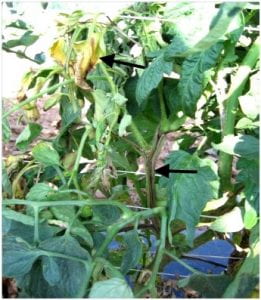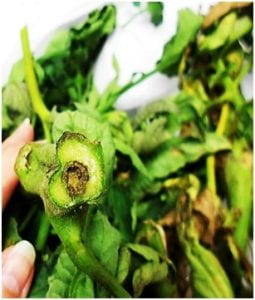Jerry Brust, IPM Vegetable Specialist, University of Maryland; jbrust@umd.edu
In the last week I have seen tomatoes from different counties in Maryland that had the same unusual disease symptoms, called tomato pith necrosis. Although most of the problem tomatoes were from high tunnels, we might expect to see the same problem from tomato fields starting in late June or early July. Tomato pith necrosis is caused by the soilborne bacterium Pseudomonas corrugata. Pith necrosis has occurred infrequently in Maryland over the past few decades. The disease usually is found in early planted tomatoes when night temperatures are cool, but the humidity is high, and plants are growing too rapidly because of excessive nitrogen application. Once night temperatures warm up, the plants usually outgrow the problem. We have had a cool spring with many cool nights in May and, at times, high humidity. In the field, diseased plants occur randomly with initial symptoms often being seen as the first fruit clusters reach the mature green stage. Symptoms include chlorosis (yellowing) of young leaves and shoots followed by wilting of the infected shoots in the upper part of the plant canopy (Fig. 1). This wilting is usually associated with internal necrosis at the base of the stem. Black streaking may be apparent on the surface of the main stem, which often splits (Fig. 2). When the stem is cut open along its length (Fig. 2) or cross-wise (Fig. 3) the pith will be discolored, and may have hollow areas (Fig. 4). There is often prolific growth of adventitious roots in the stems with discolored pith, and the stems may appear swollen.
There is not much that can be done for control of pith necrosis. The best practice is prevention by avoiding the use of excessive amounts of nitrogen in tomato, especially early in the season when nights are still cool. There is some evidence that the pathogen may be seedborne, but more research is needed on the epidemiology and management of this disease.
Figure 1. Yellow leaves and wilting of infected stem caused by tomato pith necrosis
Figure 2. Darkened pith caused by tomato pith necrosis
Figure 3. Darkened pith caused by tomato pith necrosis
Figure 4. Dark discoloration, hollow areas in the stem and adventitious roots starting in stem with tomato pith necrosis




